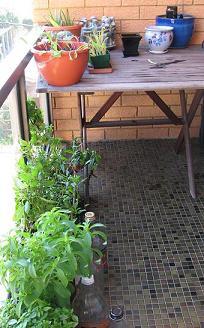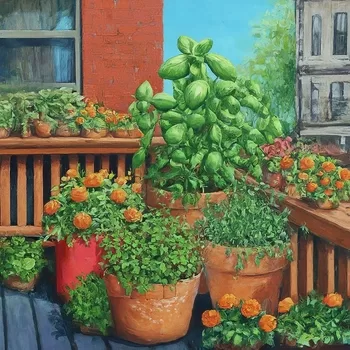Living in an apartment doesn’t mean you have to give up on the joys of gardening. Growing herbs in containers on your balcony can be a delightful and rewarding experience.
Whether you’re a seasoned gardener or a complete beginner, container gardening offers a convenient and accessible way to cultivate fresh, aromatic herbs right at your doorstep. Here’s a guide to help you get started.
Benefits of Growing Herbs in Containers

One of the main advantages of container gardening is space efficiency. Containers allow you to make the most of limited space, and even a small balcony can accommodate a variety of herb pots.
Another benefit is mobility. You can move the containers to optimize sunlight exposure or bring them indoors during harsh weather conditions.
Growing herbs in containers reduces the risk of pests and diseases compared to ground planting.
Finally, a balcony adorned with lush, green herb pots adds beauty and tranquility to your living space.
Photo: Balcony Garden … plants from from front: Greek Basil, Stevia, Sweet Basil, Thai Basil, Common Mint, Vietnamese Mint … on table: silverbeet, rosemary, aloe vera … out of shot: coriander, celery
Choosing the Right Containers
When selecting containers for your herbs, consider several factors.
First, ensure the pots are large enough to accommodate the herb’s root system. A pot with a diameter of at least 6-8 inches is ideal for most herbs.
Good drainage is crucial, so choose pots with drainage holes to prevent waterlogging.
Regarding materials, terracotta, ceramic, plastic, and fabric pots are all suitable options, each offering advantages in terms of weight, durability, and aesthetics.
Selecting the Right Herbs
Some herbs thrive particularly well in containers. Basil, for instance, loves warm weather and lots of sunlight.
Mint grows vigorously, so it is best kept in its own pot to prevent spreading.
Parsley prefers partial shade and well-drained soil, while thyme requires minimal watering and thrives in full sun.
Chives tolerate varying light conditions and are easy to maintain, and rosemary needs plenty of sunlight and well-drained soil.
Planting and Care Tips
Most herbs need at least six hours of sunlight daily, making south or west-facing balconies ideal.
Feed your herbs with a balanced, water-soluble fertilizer every few weeks during the growing season.
Regularly trim your herbs to encourage bushy growth and prevent flowering, which can cause the leaves to become bitter.
What is the best potting mix for herbs?
For planting, use a high-quality, well-draining potting mix and avoid using garden soil, which can compact in containers. Herbs in containers typically require more frequent watering than those in the ground. Water when the top inch of soil feels dry, but avoid overwatering.
Selecting the best potting soil for growing herbs in pots is essential to ensure their health and productivity. When choosing potting soil, it’s important to look for certain key characteristics.
Good drainage is crucial, as herbs need well-draining soil to prevent root rot. Potting mixes that include perlite or vermiculite can help improve drainage.
When planting herbs, ensure that your pots have drainage holes. You might also consider using a layer of gravel or broken pottery at the bottom of the pot to further improve drainage.
Herbs should be watered thoroughly but allowed to dry out slightly between waterings, as most herbs prefer not to sit in consistently wet soil.
The texture of the soil should be light and airy to allow proper root growth and aeration. Dense, heavy soils should be avoided.
Another important aspect to consider is the organic matter content. A potting mix with plenty of organic matter, such as compost or peat moss, provides essential nutrients and helps retain moisture without becoming waterlogged.


The pH level of the soil should also be balanced, as most herbs prefer a slightly acidic to neutral pH, ranging from 6.0 to 7.0. Checking the pH level of the potting mix can ensure it falls within this range.
Nutrient content is another vital factor. Herbs require essential nutrients like nitrogen, phosphorus, and potassium.
It’s beneficial to look for a potting mix that includes a balanced fertilizer, or you can add your own organic fertilizers, such as worm castings or compost tea.
Commercial potting mixes that work well for herbs are rich in organic materials and beneficial microbes, and that contain natural ingredients and mycorrhizae to promote healthy root growth and nutrient uptake.
Homemade Potting Mix
For a homemade potting mix, a good recipe includes equal parts of potting soil or garden soil, compost or well-rotted manure, and perlite or coarse sand for drainage. Adding a handful of lime can help adjust the pH if you are using acidic compost.
Troubleshooting Common Problems
Yellowing leaves are often a sign of overwatering or poor drainage. Wilting can be due to underwatering, overwatering, or excessive heat. Common pests include aphids and spider mites, which can be treated with insecticidal soap or neem oil.
Creative Ideas for Your Herb Garden
To maximize space, consider using hanging pots or wall-mounted planters to create vertical gardens. Stack pots of different sizes to create a multi-tiered herb tower. You can also combine different herbs in larger containers for a vibrant, mixed display.
Growing herbs in containers
Growing herbs in containers on your apartment balcony is a simple and enjoyable way to enhance your living space and culinary experiences.
With a little care and creativity, you can have a thriving herb garden that not only provides fresh ingredients for your meals but also adds a touch of nature to your urban lifestyle. Happy gardening!
Related stories
Our Gardening section
Australia’s best tasting heirloom tomatoes
Global Food Production Dilemma: Grow & Buy Local
Farmers prepare for supercharged El Niño
Moss is vital for the health of soils – here’s why
Do you want to live on an Intentional Community



